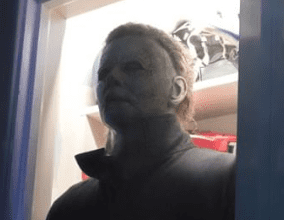Halloween 2018 Review (Spoilers)
22nd October 2018
View this post on Instagram
Don’t. Miss. Out. Get tickets to see #HalloweenMovie, NOW PLAYING in theaters – Link in bio.
After 40 years of anticipation, Michael Myers has returned to cinema screens to terrify a new generation. Starring Jamie Lee Curtis, Judy Greer and Andi Matichak, the sequel to John Carpenter’s Halloween (released in 1978) has accumulated rave reviews, being dubbed ‘slasher of the year’ and ‘no tricks, a total treat’.
After watching the movie, I cannot say I am in consensus with the critics.
Although the Halloween franchise has released 8 movies in total, producer David Gordon Green asks us to disregard any memory of the movies but the first one, this because the 2018 version follows on directly from it. The premise of the sequel follows killing spree survivor, Laurie Strode, (Jamie Lee Curtis) who has been plagued by PTSD for 40 years since the fateful night that Meyers attacked her, or so the synopsis and trailer implies.
The movie begins with two investigative journalists, Dana and Aaron, who visit Michael at the mental hospital/prison facility, where he has been for the past four decades. Aware that Meyers has been analysed by 50 clinical psychologists (all of whom have gained zero information about his motives), these two frankly invasive and asking-for-trouble folks think they will be able to get an insight into why he did what he did on that Halloween night.
Aaron and Dana approach Michael, flashing him the mask he wore during his massacre in hopes of triggering some sort of response – they fail to get one. Aaron persists, shouting ‘you feel it don’t you, Michael?’
To be transparent; these two journalists serve no purpose in the narrative, in my opinion. Aaron and Dana are represented as the trigger for Michael wanting finish off Laurie. Those characters were just not needed, for Michael didn’t need to be triggered; his obsession with Laurie and the knowledge of her still being alive was reason enough for him to reunite with her again.
Getting nowhere with Michael, Aaron and Dana travel to Haddonfield, Illinois to seek out Laurie, who has been living in isolation in the woods.
First of all, I found this rather hard to buy into. Sure, I understood the symbolism of Laurie’s isolation due to her trauma, but if some guy tried to kill you, would you make yourself a target by living all alone in the middle of nowhere? Wouldn’t it make sense to move state, or at least to a suburb where you will less likely be found?Apparently not (movies in the horror genre feature some plot lines which must be taken with a pinch of salt).
Second of all, the journalists (whose lives are pretty short-lived), never finish the case. For a movie that seeks to understand Michael’s psyche, we learn absolutely nothing about the reasons behind his actions. After 1 hour 45 of relentless carnage, we come to the conclusion that Michael is nothing but a barbaric animal – that is the reason.
In fairness, I think Halloween did have something to say. Its representation of trauma is impressive, but I would give the credence to Jamie Lee Curtis for her exceptional acting. Laurie, due to being a victim of random violence, has lived her life in a cycle of fear and anxiety; these two things resulting in two divorces and the state taking away her daughter Karen (Judy Greer) at the age of 12.
Now grown up with her own daughter, Allyson, Karen’s relationship with her mother Laurie is non-existent. Allyson (Andi Matichak) however, wants to have a close relationship with Laurie; a relationship Laurie is unable to provide.
There are several scenes in which Curtis brought tears to my eyes. In one part of the movie, Allyson wants Laurie to come to dinner to meet her new boyfriend, to which Karen responds “she won’t be able to do that, honey, she’s agoraphobic’. Showing up at the restaurant fuelled with alcohol and emotionally unstable, Laurie’s cracks under the pressure of being in a public place. She breaks down, stating that Michael is coming back for her and that she can’t move on.
Curtis’ performance of troubled Laurie is authentic and representative of what’s left of a person’s mental well-being and sense of self after surviving such an indelible trauma. I do wish that this trauma had been explored more, and the relationships in Laurie’s life could have been more of a focal point.
Karen is rather cruel to Laurie; telling her that she needs therapy, and failure to get help means that she is not welcome in her and Allyson’s lives. Allyson, although sympathetic at times, even tells Laurie in one scene to ‘say goodbye to Michael, and get over it’.
This speaks to the attitudes towards mental health and the stigma it carries to this day. The way in which Laurie’s trauma/PTSD is treated and dismissed by those around her displays just how isolating it is when nobody understands. Halloween also shows how much trauma can affect generations, with Laurie’s anxiety being passed on to Karen, who has then passed it onto Allyson.
Meanwhile, we know before even entering the cinema that Michael escapes en route to another mental facility.
Michael finds his way back to Haddonfield by car – a car he steals from an innocent man before killing him (yes, after 40 years of no driving, Michael knows how to operate a car perfectly and knows the exact route to Laurie’s house without Google Maps!)
Before going to her place, Michael takes a detour to a suburban neighbourhood where carnage ensues. Although the movie is rated 18 and is of the horror genre, the excessive violence in this movie is relentless and, frankly, traumatic.
Michael’s body count is so high, going house to house via the back door and killing off folk who have no relevance to the plot (I surmise the takeaway message is when the news broadcasts that several mental patients, including ‘the babysitter killer’ Michael Myers, have escaped – it may be best to lock your doors!). The kills almost seem like a means of passing time until we get to the anticipated reunion of Michael and Laurie.
Aside from the criticisms I have of Halloween, the reunion of Strode and Meyers is a showdown that is so suspense-filled that it leaves you gasping for breath (kudos to producer David Gordon Green, whose suspense was comparable to Hitchcock’s Psycho).
Laurie is incredibly resourceful and has all the equipment, booby traps and firearm training for the reunion after 40 years of clearly doing not much else. In a time where the #MeToo movement is so relevant, I think Halloween reflects the context in which it was made. It is highly symbolic of women facing the perpetrator of their trauma and saying “no more”, which is what Laurie does when she finally faces Michael.
David Gordon Green attempts to capture some of John Carpenter’s original; reusing the opening sequence, theme song and even (very noticeably) replicating some scenes. The acting in this movie was great, however, I believe it failed Jamie Lee Curtis: as the supposed protagonist she wasn’t in it all that much.
In conclusion, Halloween has a powerful message about trauma, but that message is lost in the unnecessary, gory carnage and irrelevant characters who took away from Laurie’s story. I would recommend seeing this movie if you are a fan of Jamie Lee Curtis, but wouldn’t recommend having high hopes.

